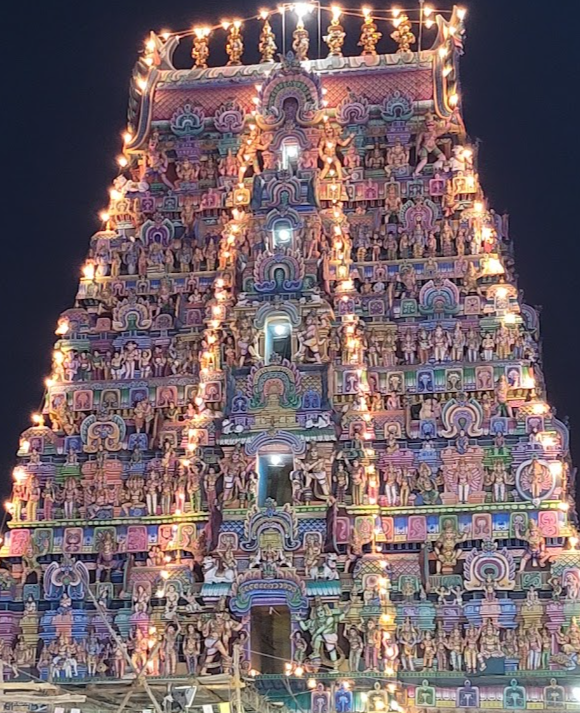Sekkizhar lived during the reign of King Anabaya Chola and made significant contributions to Saivite philosophy and Tamil literature through his magnum opus, Periya Puranam, which extols the greatness of the 63 Nayanmars. Known as Arulmozhi Thevar, he was honoured with the community title of Sekkizhar and bestowed the title Uthama Chozha Pallava by King Anabaya.
During one of his visits to Thirunageswaram, near Kumbakonam—an area associated with the planet Rahu—Sekkizhar worshipped Lord Nageswarar and felt a deep desire to experience this darshan daily. However, the long distance from his home made this impractical. In response, he decided to construct a temple modelled after the original, where he installed a Shiva Lingam and named it Lord Nageswarar. This temple became known as Vada Nageswaram, or North Nageswaram.
Sthala Puranam :
On the night of Maha Sivaratri, Nagaraja, the lord of the nagas, is said to have worshipped Lord Shiva at four temples, one during each jamam (period) of the night. The sequence of these temples is as follows: the Nageswarar temple at Kumbakonam, the Nageswarar temple at Thirunageswaram, the Seshapureeswarar temple at Thirupampuram, and the Naganathar temple at Nagore. This region was once known as Champakavanam (or Shenbagaranyam), named after the forest of Champaka (Shenbagam) trees that thrived there.
Sekkizhar, the compiler of Periya Puranam, performed the inaugural recital of his epic at this temple, making it one of his favourite places. Consequently, the presiding deity at the temple in Kunnathur, Chennai—Sekkizhar’s birthplace—is Naganathar.
Once, Sukarma, the son of Sage Suseelar, was bitten by Takshaka the snake. As a result, Sage Suseelar cursed Takshaka to be reborn as a human. Seeking redemption, Takshaka approached Sage Kashyapa, who advised him to install a Lingam and worship Shiva at this location. After performing much penance, Takshaka was blessed by Shiva and relieved from his curse.
Upon hearing of these events, Rahu realised this place would be safe for him and chose to reside here permanently with his wives, Simhi and Chitralekha. In this temple, Rahu is said to assume a benevolent form, blessing devotees with positive outcomes and alleviating obstacles in their lives. Thus, this temple is recognized as a Rahu sthalam and is part of the Kumbakonam Navagraha temples, also serving as a sarpa dosha nivritti sthalam. Uniquely, Rahu has a separate shrine in the northeastern portion of the second prakaram, depicted with a human face—unlike at most other temples. It is believed that the milk offered to Rahu for abhishekam during rahu kalam time turns blue.
During the churning of the ocean, Vishnu, in the form of Mohini, ensured that only the Devas would receive the amritam (nectar of immortality). However, one asura, advised by Sukracharya, disguised himself as a Deva and received the amritam. Suryan and Chandran alerted Vishnu, who then tapped the asura with the ladle used to distribute the nectar, resulting in the asura’s head being severed. The remorseful asura prayed to Lord Shiva, who granted him the dual identity of Rahu and Ketu, allowing them to take their place among the planets. This act has led to Rahu and Ketu occasionally seeking revenge on Suryan and Chandran by causing solar and lunar eclipses.
In addition to Takshaka and Rahu, various nagas are associated with worship at this temple, including Karkotakan and Adiseshan, the latter being the first of the nagas to receive darshan of Shiva here. As a result, the deity came to be known as Nanganathar or Nageswarar.
Administration History :
The administration of the Naganathaswamy Temple in Thirunageswaram has evolved significantly over the centuries, reflecting the patronage of various dynasties. Initially, it was under the care of the Chozha kings, with inscriptions documenting endowments and renovations during the reigns of Rajaraja Chozha and Rajendra Chozha. The temple saw continued improvements and extensions during the Vijayanagara period, particularly through the efforts of Govinda Deekshithar. Local merchant communities, such as the Perunagarattar, played a crucial role in the temple's upkeep, contributing funds for renovations and worship. Inscriptions from different periods illustrate the temple's importance as a centre for religious and community activities, with established systems for managing offerings and worship practices.
